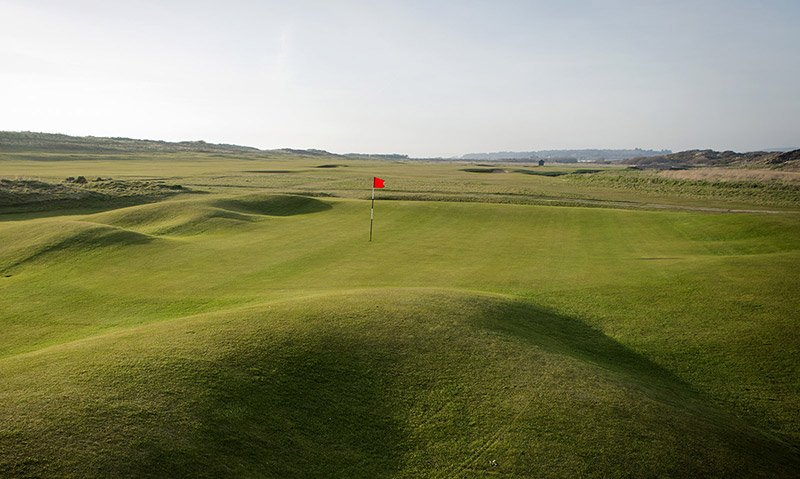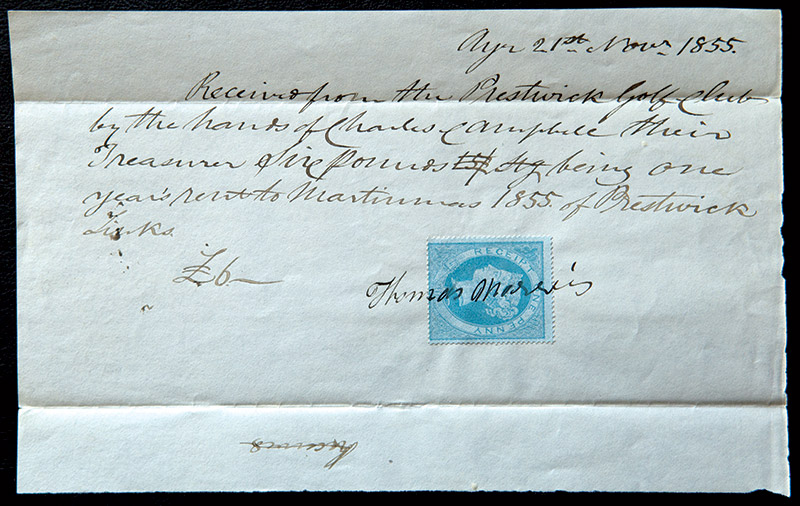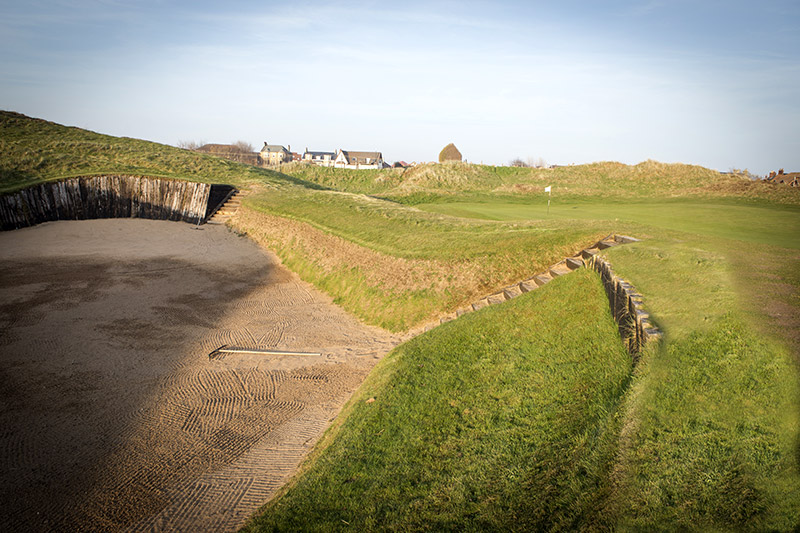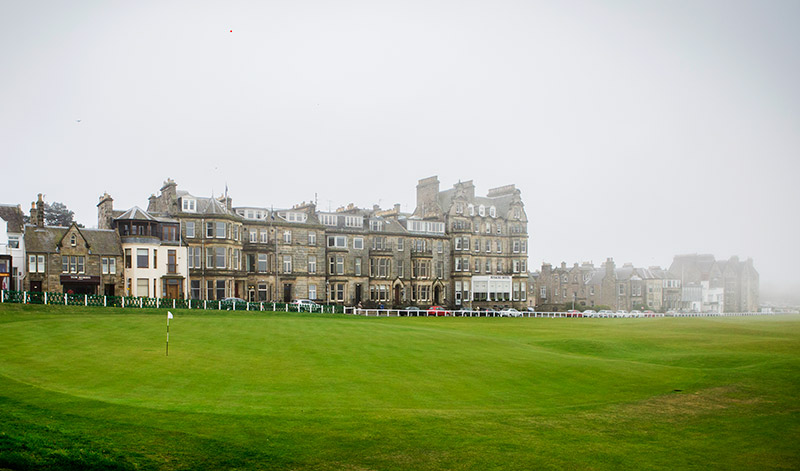
Spring is being kind, and there is the gentlest of prevailing breezes sweeping across Prestwick Golf Club from the Firth of Clyde. The skies are blue and surprisingly warm for April—perfect conditions for a game—but we are not here to play golf, we are here to embark on a journey from one side of Scotland to the other, from Prestwick on the west coast to St Andrews on the east, as Old Tom Morris did himself 150 years ago (plus six months).

I tend to warn visitors…if they can see a flag ahead they are probably not facing in the right direction
“I tend to warn visitors who don’t know the course,” starts Ken Goodwin, secretary at Prestwick Golf Club, “that when they stand on a tee, if they can see a flag ahead they are probably not facing in the right direction.”
And therein lies the essence of this historic golf course. It is eccentric by modern standards, but when Old Tom Morris came here in 1851 to lay out the course, he set the standard for the design of links courses for generations to come.
“Prestwick was the first course Tom laid out, and his approach to golf course design was to first find a good place for a green,” adds Goodwin. “Once he had identified that, he would find another good place for a green, and so it went on. If there happened to be a sand dune or a depression on the road to the green then it was up to the golfer to negotiate it, one way or another.”
The golf course at Prestwick, which started as 12 holes in 1851 and was partly re-routed and expanded to 18 holes 30 years later, includes a rare treasure of golf design, a blind par three: the Himalayas.
“Himalayas has a big sand dune between the tee and the green,” explains Goodwin. “You would never be allowed to build that hole today. Modern pros would hate it in a tournament, but when the Open is at Troon or Turnberry we get a lot of them coming here to play the course for fun, and they think it’s great. Golf in the early days was all about negotiating obstacles like the one on our fifth hole.”
As a young club and ball maker of St Andrews, and not long married, Morris was keen to broaden his experience and made the bold decision to accept the job of “Keeper of the Green” at Prestwick, a new club all the way on the opposite coastline of Scotland, at “a place in the vicinity of Ayr, called Prestwick,” as one Fife newspaper reported in 1851.
The 110-mile journey from St Andrews to Prestwick, east coast to west, was into the unknown in many ways.
“Morris was well liked at St Andrews and I think he surprised a lot of people when he moved to Prestwick,” starts Andrew Lochhead, a member at Prestwick GC and the club’s archivist. “He didn’t have any previous connection with the town and it was a long journey from home: a day’s travelling incorporating trains and horse and cart. He did it with a young wife and newborn child too—‘Young’ Tom was only a couple months old. He took a bit of a gamble leaving all his existing friends and customers behind for the unknown quantity of Prestwick.”
Morris’s move would ultimately be vindicated by the inauguration of the Open Championship, in 1860, upon the very links he created with his own hands. The members of Prestwick organised the first Open in the hope of proving that their man, Morris, was the best golfer of his day, but Musselburgh’s Willie Park—the great rival of Morris—refused to fall into line and won the Champion’s Belt for the first time. But that is another story.

At Prestwick, Morris was ‘Keeper of the green, club maker and ball maker’, with an annual salary of £36 (although his wages were well supplemented by exhibition and challenge matches, and from selling clubs and balls), and it was this job that established the role of the club professional. Morris was the first.
Morris would fix any problems on the course with ‘sand, sand and more sand’
It was at Prestwick that Morris discovered that laying sand onto greens improved their condition. “Morris would fix any problems on the course with ‘sand, sand and more sand’,” says Goodwin. “That still holds true today. We still top dress our greens with sand.”

Morris earned an annual salary of £36 (around $175 at 1860 exchange rates) at Prestwick, and always with a keen sense of his own worth, he would supplement his income with exhibition and challenge matches (see story on page 94), and from selling clubs and balls. It was this position that established the role of the club professional. Morris was the first.
It was at Prestwick that Morris discovered that laying sand onto greens improved their condition. “Morris would fix any problems on the course with ‘sand, sand and more sand,’” says Goodwin. “That still holds true today. We still top dress our greens with sand.”
“It is amazing how the game has evolved since Old Tom Morris came here and designed the golf course, worked as greenkeeper, professional and club maker,” says David Fleming, who took up the baton at Prestwick as club professional in 2004 and is only the club’s eighth professional since 1851. “I would love to know how Old Tom managed his time! With the exhibition matches I honestly don’t know how he managed it all. To be such a great course designer, player, greenkeeper and club maker, Old Tom was incredibly gifted. He puts us all to shame today!”

From 1861, Morris won four of the next seven Open Championships, all at Prestwick, and he was such a success in terms of playing, greenkeeping and his other extended duties, that the gentlemen members of the Royal and Ancient Golf Club wanted him back in St Andrews. The offer of a £50 annual salary and a return home was too good to refuse.
I think Morris was always destined to return to his hometown at some point
“I think Morris was always destined to return to his hometown at some point,” adds Lochhead. “I expect he missed St Andrews by the time he returned in 1864. Prestwick Golf Club was grateful to receive the benefits of his services for 14 years.”
“In those days there were two distinct social classes,” adds Goodwin, “and for the gentlemen members of Prestwick Golf Club to hold a farewell dinner to honor Tom Morris before he left, that shows you how highly he was regarded.”
For Morris and his young family, that journey back to the east coast of Scotland would have taken all day, picking up trains from Prestwick to Glasgow, Glasgow to Edinburgh, Edinburgh to Granton, and then by train ferry to Bruntisland, and then up to Leuchars Junction and St Andrews. About as complicated as a 110-mile journey could be.
The railways do not run those connections any more, so to follow the footsteps of Morris from Prestwick to St Andrews we were forced to travel by car. Morris was nothing if not a progressive thinker, and we like to think he would have approved in the advances from horse drawn cart to motorized car, slashing the coast-to-coast journey time by at least 80 percent. It’s a bit like comparing one of Morris’s handmade hickory clubs to Callaway’s latest Big Bertha.
So 14 years after Morris left St Andrews, the Royal and Ancient Golf Club lured him back. He was comfortably the best qualified and proven man to run the Old Course and serve the golfers of St Andrews. As detailed in ‘Tom Morris of St Andrews, The Colossus of Golf’ by David Malcolm and Peter Crabtree, The Fifeshire Journal reported Tom’s return thus, on 24 November 1864:
“Tom Morris has arrived to enter upon his duties as Conservator of the Links and we doubt not that his return amongst us will add more item to the popularity of the national game.”
They got that right. Morris officially began his new job on December 19, 1864, although Malcolm and Crabtree write that it was not until the New Year of 1865 that Morris was “presented with the tools of his office—a barrow, spade and shovel.” In 1866, the well-established Morris joined the property ladder for the first time and moved the family into No. 6 Pilmour Links, and his business into a new shop on The Links.

Morris’ work was based in that shop for the next 39 years, until his reluctant retirement in 1903 at the age of 82, and he lived at No. 6 until his death in 1908, at the age of 86.
Owned by the St Andrews Links Trust, the “Tom Morris” shop remains open to this day, and, fittingly, it retails the Tom Morris clothing brand. It occupies a prime spot in St Andrews, overlooking the 18th green of the Old Course, just down from the prestigous burgundy-brick Hamilton Grand redevelopment at one end of the road and the Old Course Hotel at the other. The Old Course Hotel—the discerning golfer’s hotel of choice in St Andrews—offers a level of comfort and luxury that Old Tom probably could not have imagined, but also one that he would surely enjoy, given the chance.
Nine years after Morris’ return to St Andrews, the Open was held on the Old Course for the first time, in no small part due to Morris’ expertise as “Conservator of the Links.” Without Morris the history of golf’s oldest major would be very different. The residents of St Andrews thought so, and after Morris died the town’s golf clubs collaborated to commission a bronze of Morris, which was installed beneath the clock on the outside of the R&A clubhouse, in fitting isolation, overlooking the first tee of his beloved Old Course.
Follow Us On


| Cookie | Duration | Description |
|---|---|---|
| cookielawinfo-checkbox-analytics | 11 months | This cookie is set by GDPR Cookie Consent plugin. The cookie is used to store the user consent for the cookies in the category "Analytics". |
| cookielawinfo-checkbox-functional | 11 months | The cookie is set by GDPR cookie consent to record the user consent for the cookies in the category "Functional". |
| cookielawinfo-checkbox-necessary | 11 months | This cookie is set by GDPR Cookie Consent plugin. The cookies is used to store the user consent for the cookies in the category "Necessary". |
| cookielawinfo-checkbox-others | 11 months | This cookie is set by GDPR Cookie Consent plugin. The cookie is used to store the user consent for the cookies in the category "Other. |
| cookielawinfo-checkbox-performance | 11 months | This cookie is set by GDPR Cookie Consent plugin. The cookie is used to store the user consent for the cookies in the category "Performance". |
| viewed_cookie_policy | 11 months | The cookie is set by the GDPR Cookie Consent plugin and is used to store whether or not user has consented to the use of cookies. It does not store any personal data. |